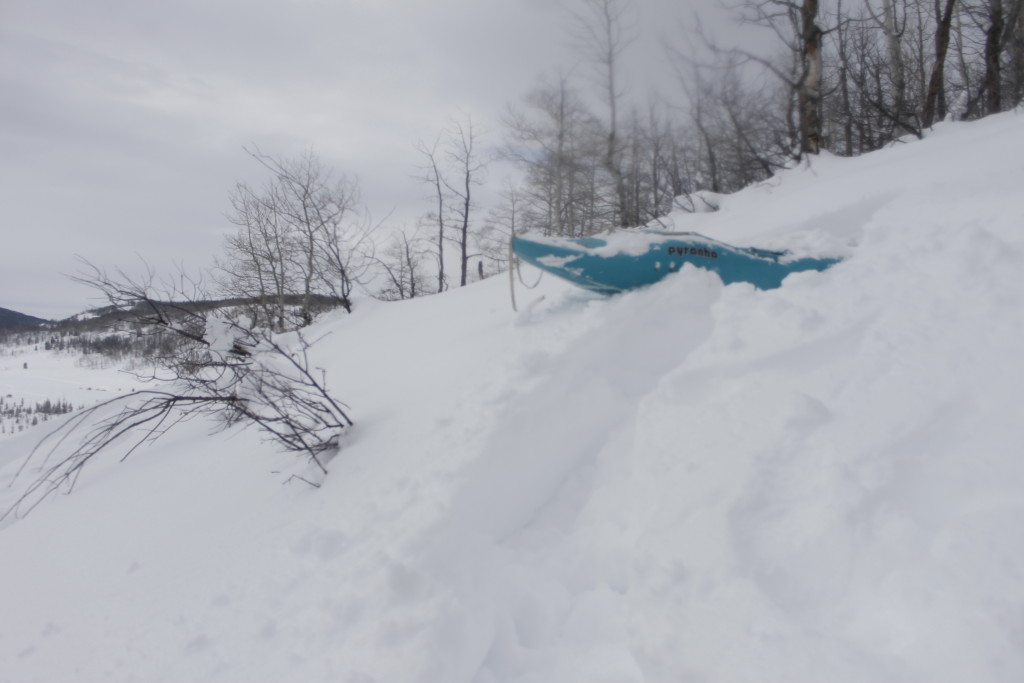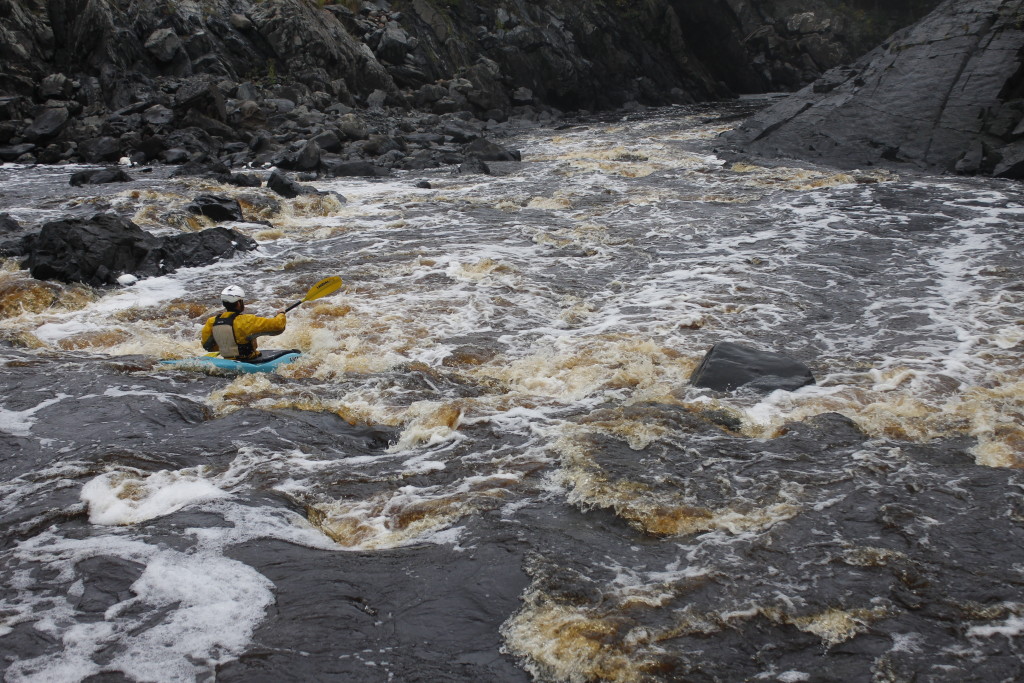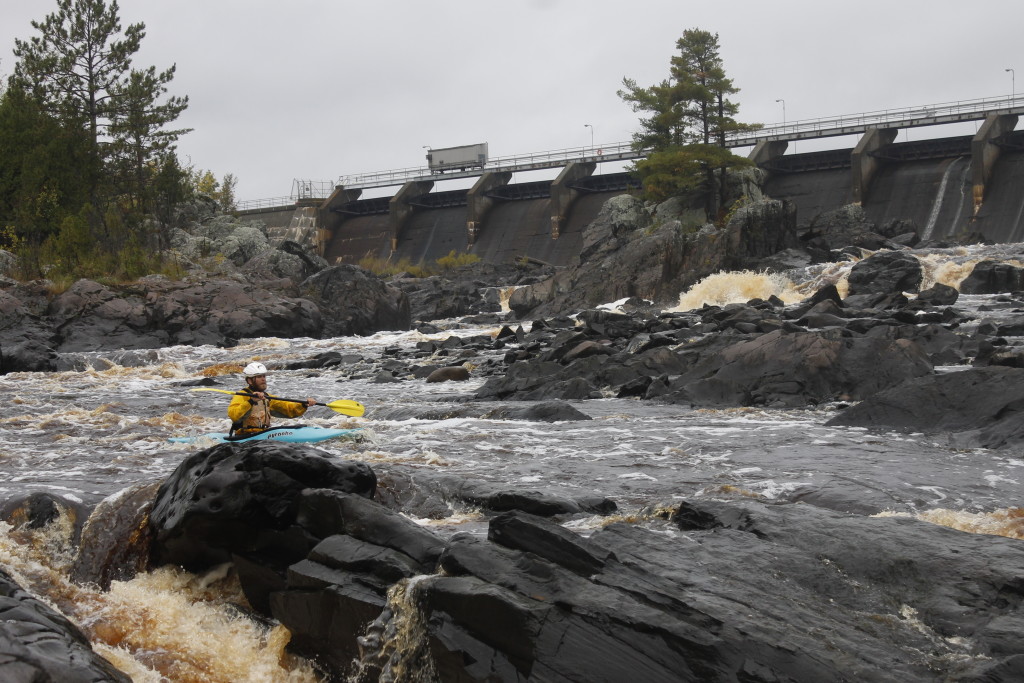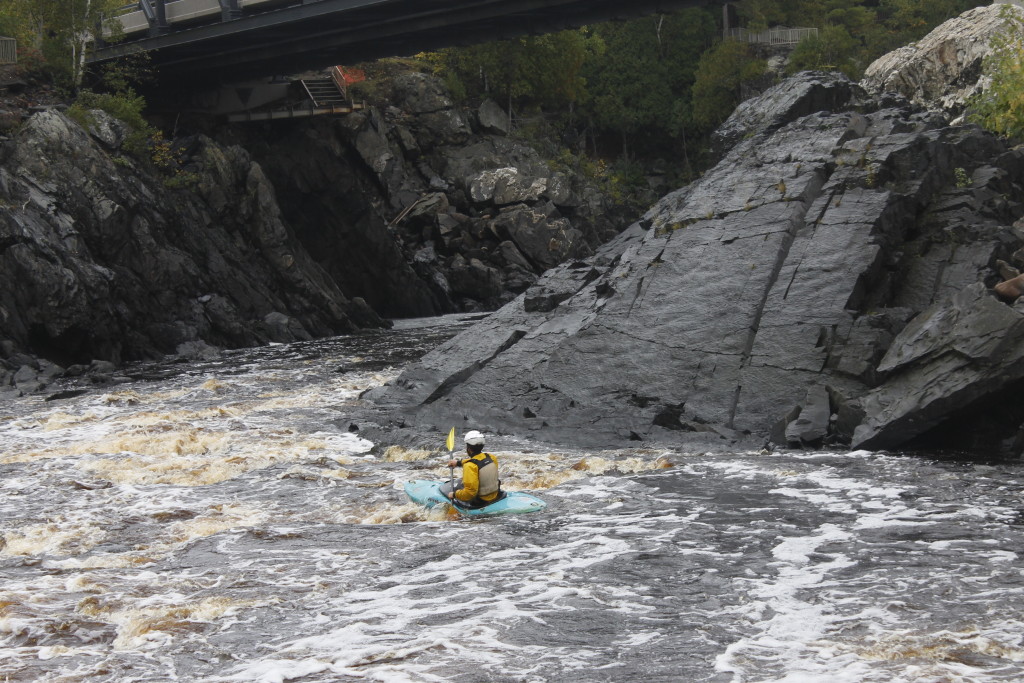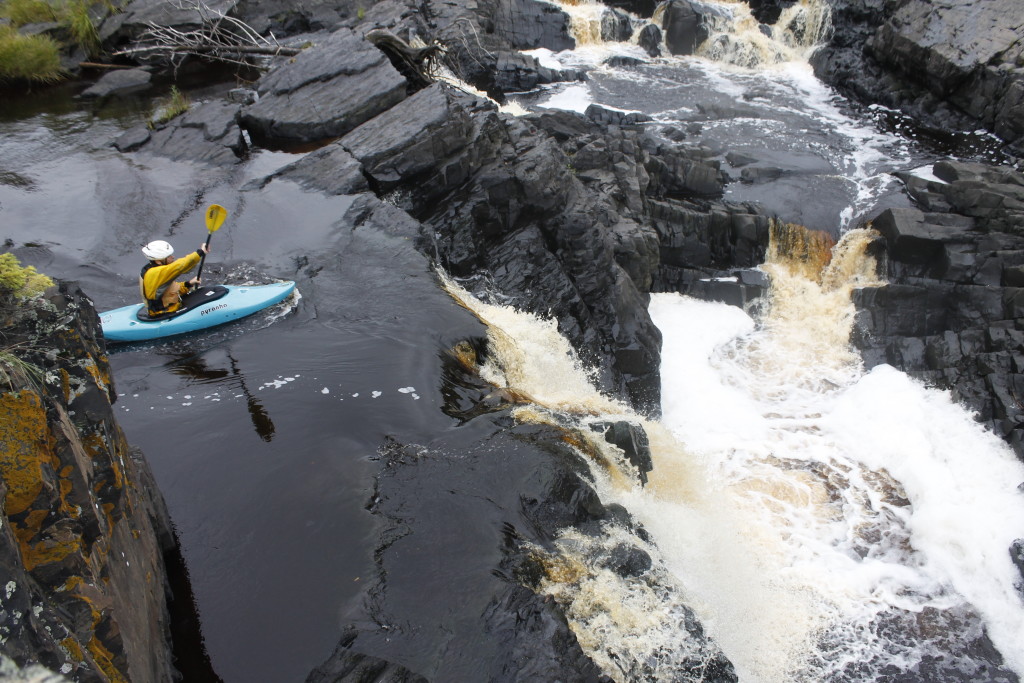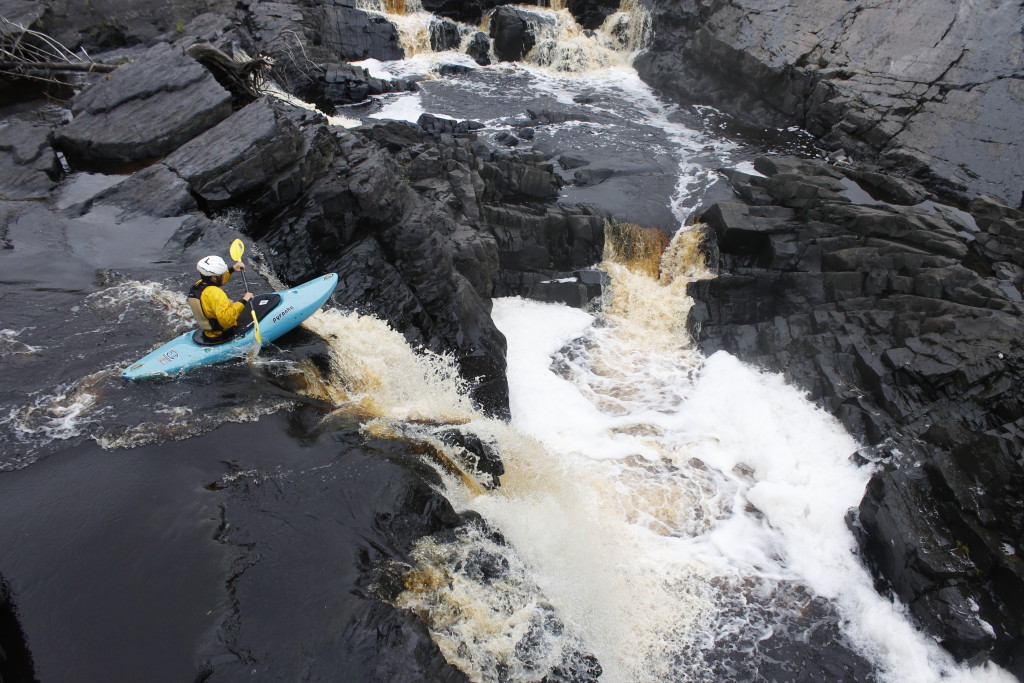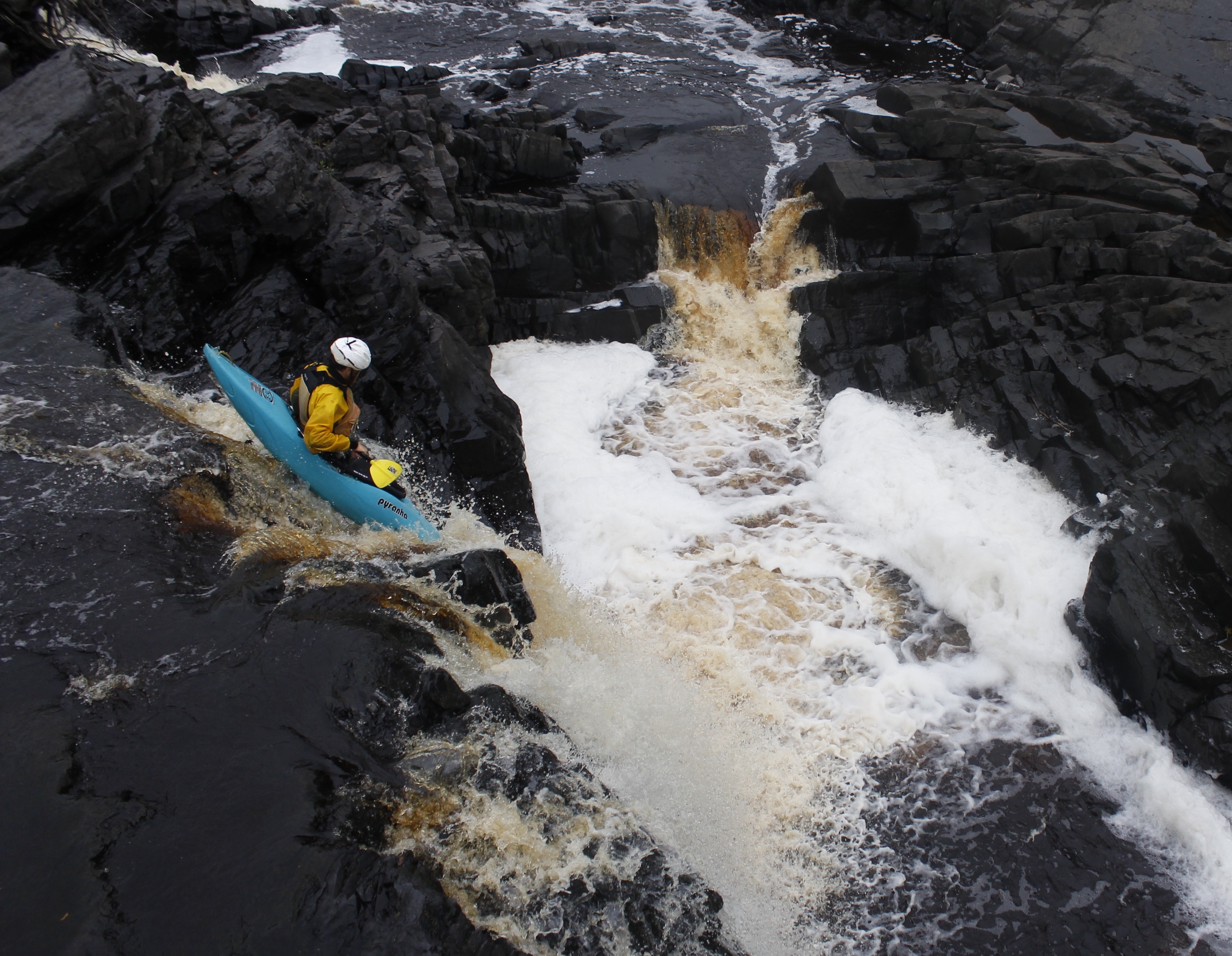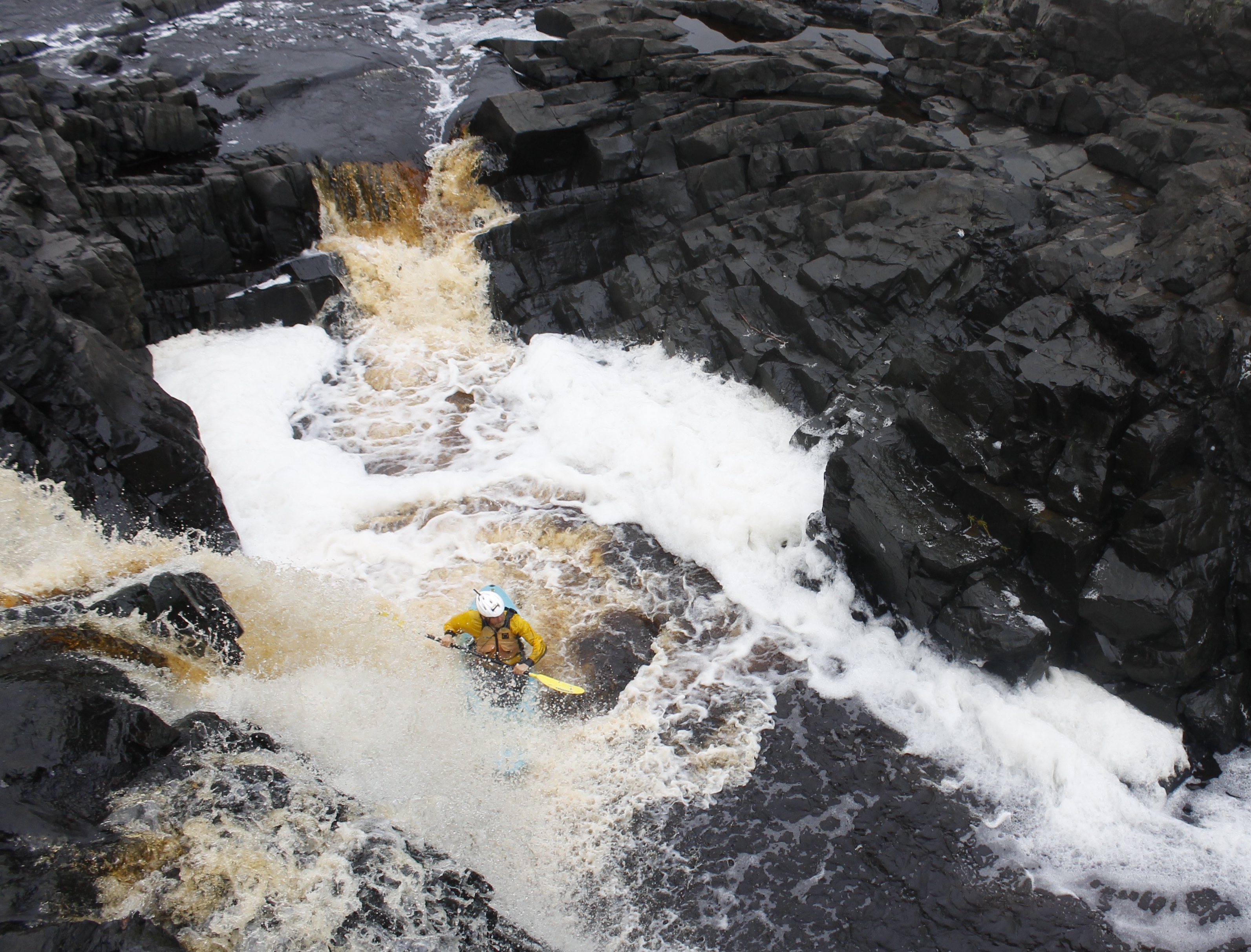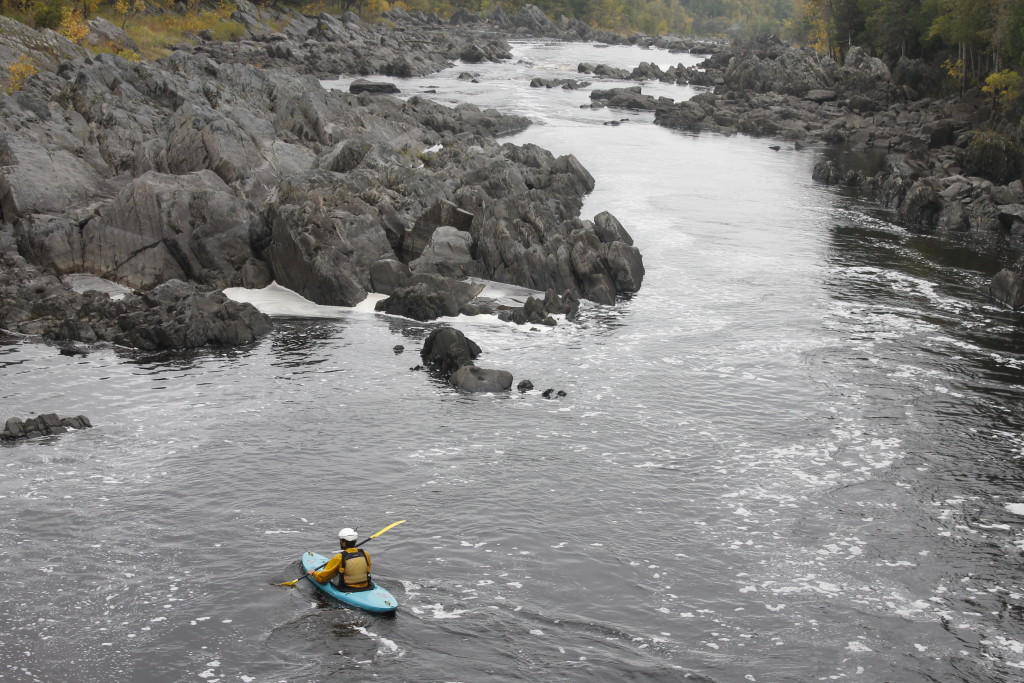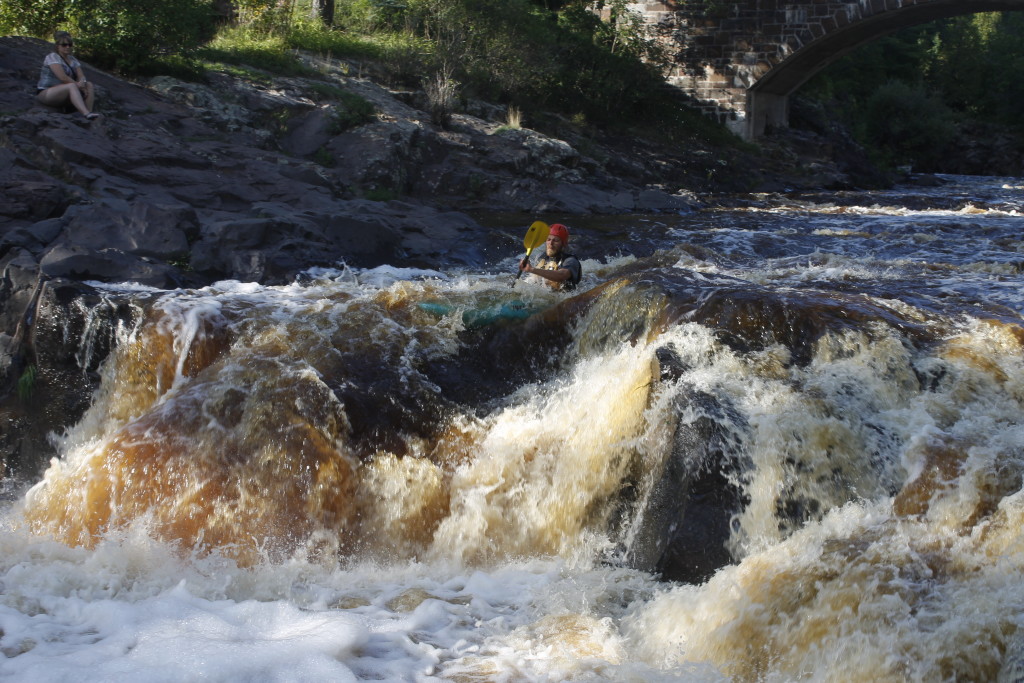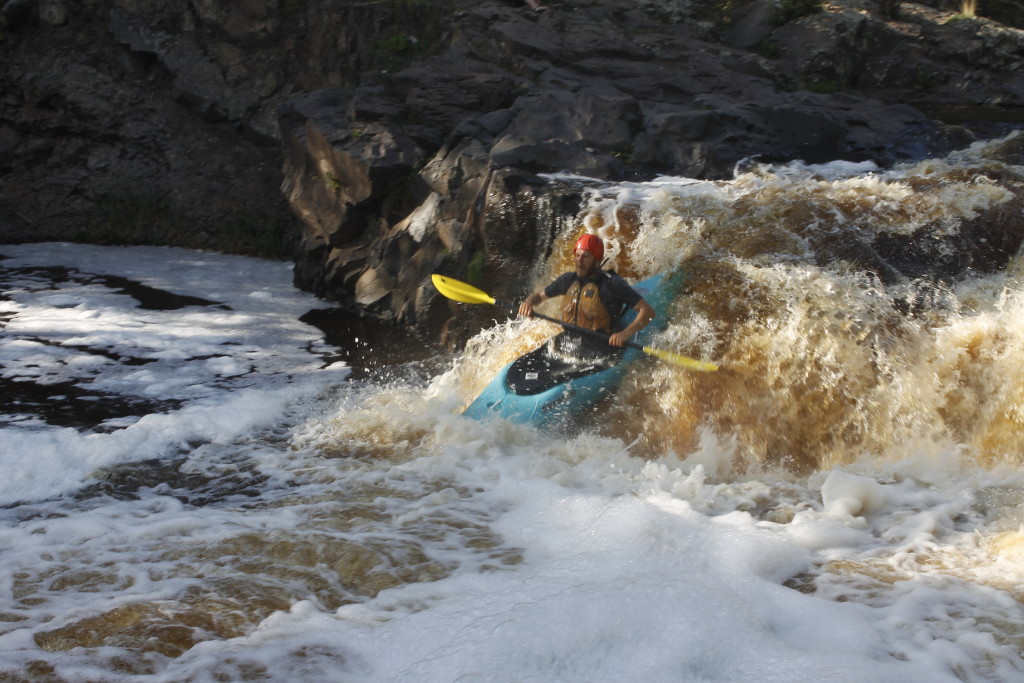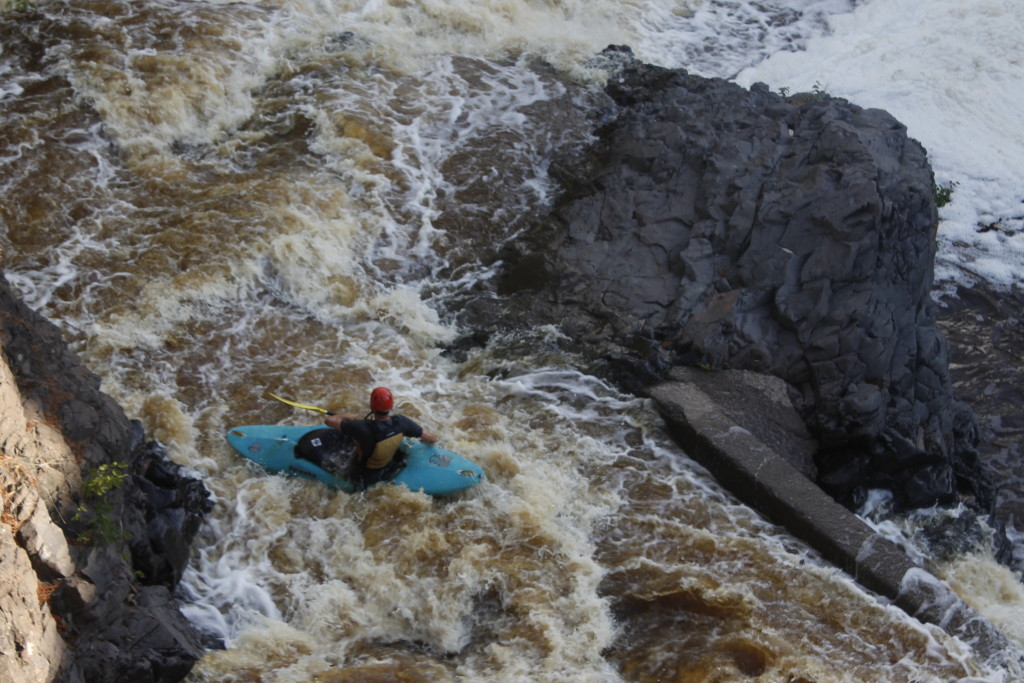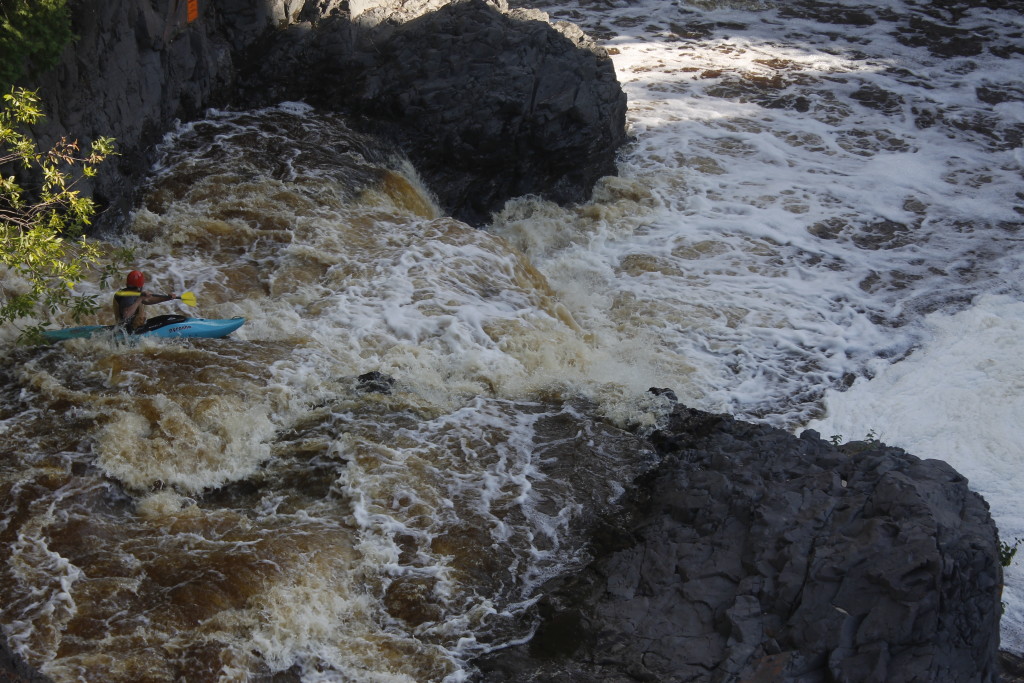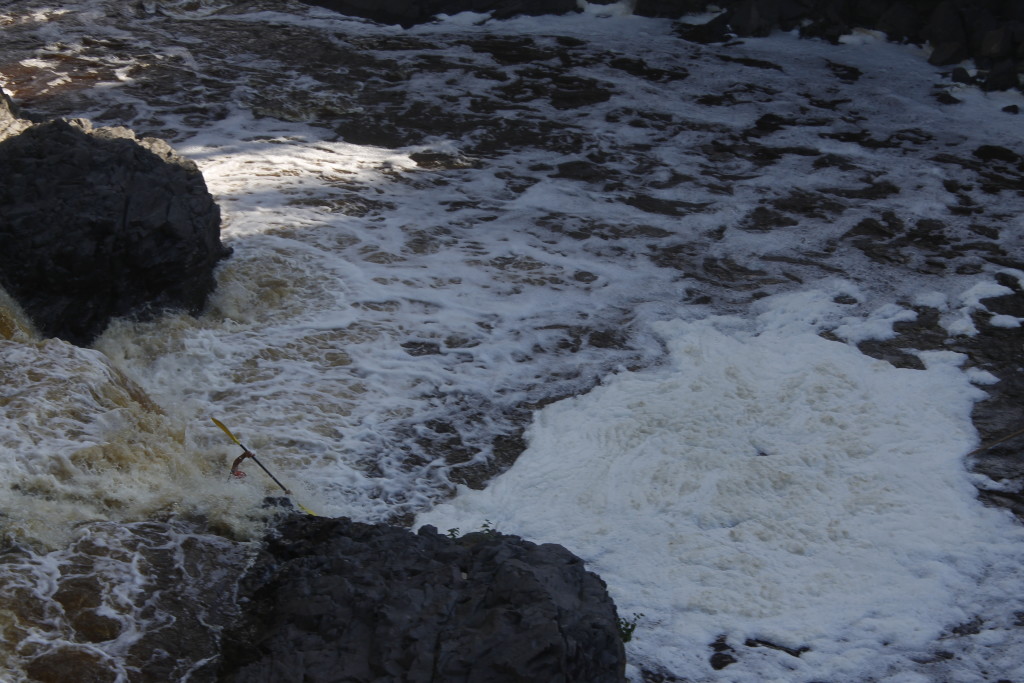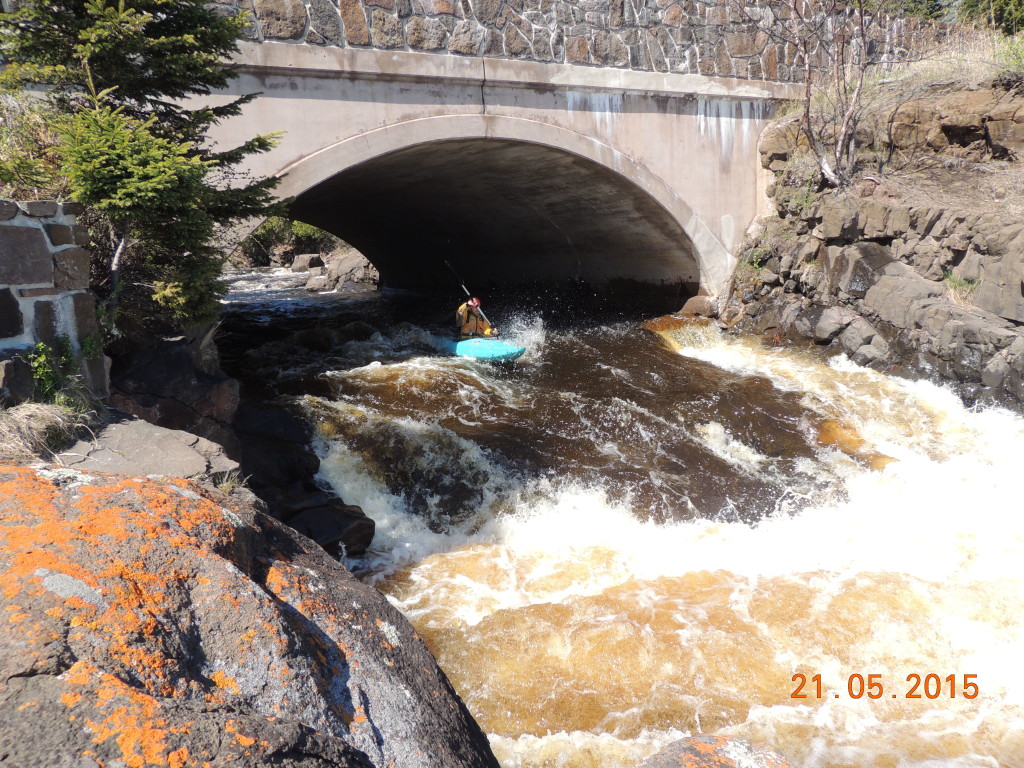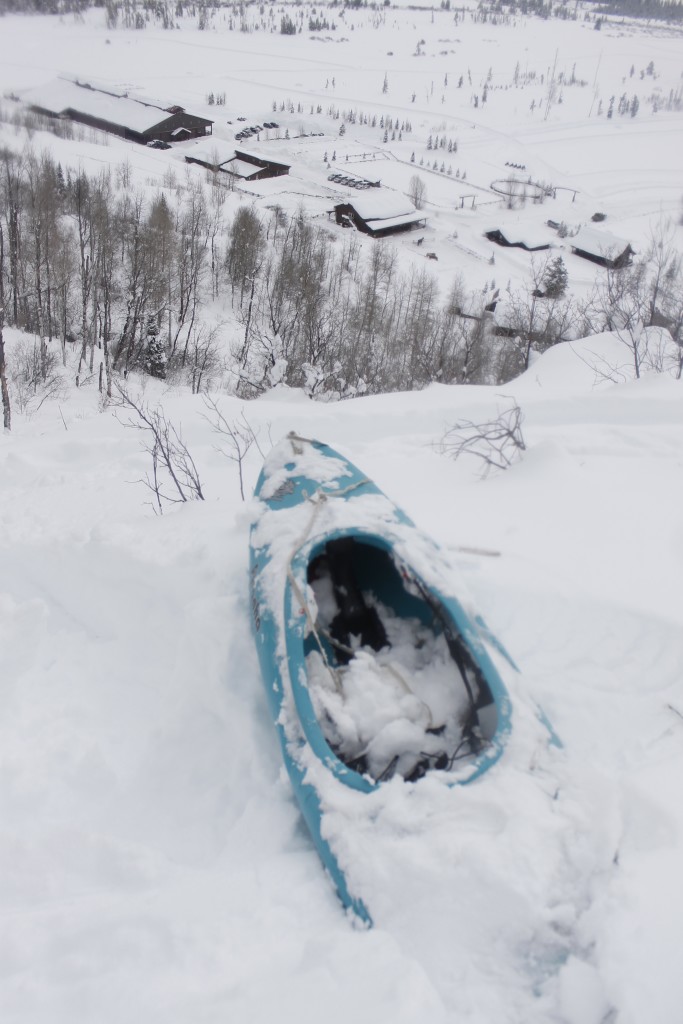
Wipeout in a whiteout
The kayak barely moved at first. I had to wriggle back and forth to inch it forward on the snow ledge I’d created. I saw the chunks of crust break away as gravity grabbed hold of the bow. Then the boat tilted over and we started tearing down the gully.
White powder sprayed up into my face. I could barely see what was happening, only that I was moving very fast. My efforts to steer with the paddle hardly mattered; down was the only direction my boat was interested in going — and it was going that way faster and faster. I squinted ahead to the fast approaching tree stand, wondering how the hell I was going to thread my way through.
Something bumped beneath my hull. The world instantly flipped upside-down and went white. My head was buried in the snow.
The ride was over.
I flipped myself right-side up, observed that my boat was almost completely buried in powder and that my paddle had flung out several yards down slope from me. To retrieve it, I had to take my sprayskirt off and wade through waist-deep snow. I’d need that paddle to get the rest of the way down the hill.
In the traditional model, I would wait to go kayaking until the snowmelt.
The powder on the mountains here in Routt County will begin feeding the rivers in a couple of months. Rivulets beneath the crust will merge, feed into drainage gullies, streams and willow fens, down to the Elk River in the Colorado River system. From the Yampa, to the Green River and eventually the Grand Canyon, the melting white stuff will build standing waves and hydraulics for whitewater kayaks and rafts to play in.
But just because the snow hasn’t melted, doesn’t mean that I can’t kayak over it. All it takes is a steep enough hill and a lot of powder.
Climbing with a paddle
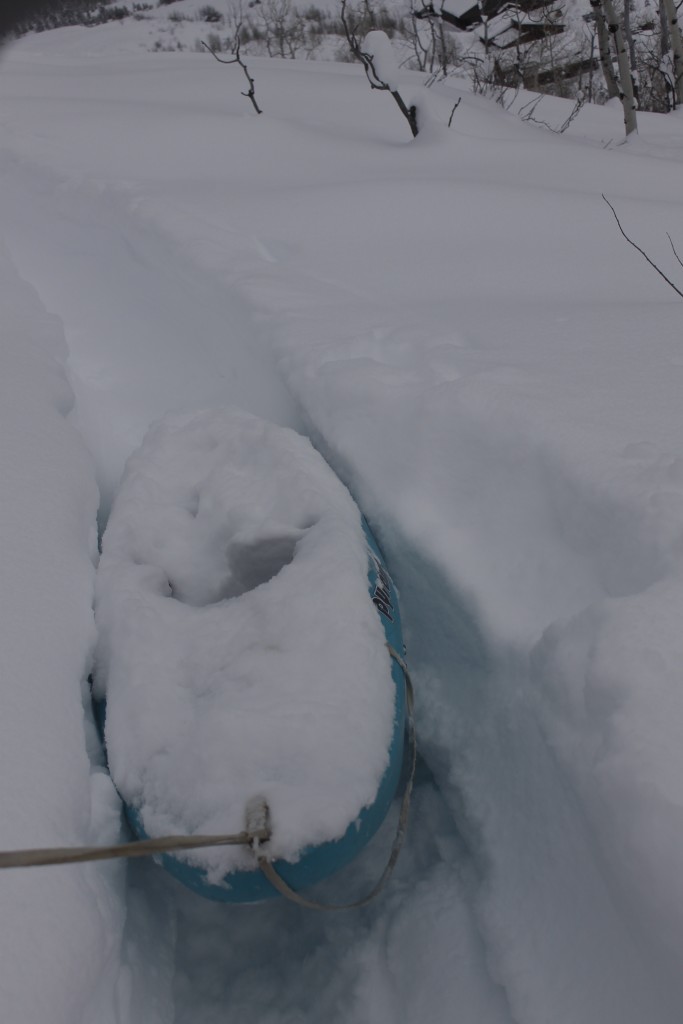
Getting a kayak to that steep hill is the first challenge. My system involves snowshoes, a backpack, carabiner, rope, and a canoe paddle. I set the ascender bars on the snowshoes and start wallowing up the deep powder with the rope tied to the bow, clipped to the carabiner on my backpack. The first run is always the hardest because I’m breaking trail and pulling my kayak uphill through powder. I lean forward like some hobbled supplicant, praying that the kayak won’t yank me off my feet.
In some ways, the canoe paddle in my hands works even better than the hiking poles I typically use with snowshoes. Paddling the powder on flat sections gives me a decent momentum boost from my upper body. The paddle also balances me. I can brace the flat of the blade against the snow, much as I would use a high brace to prevent a kayak from capsizing in waves. When the going gets steeper, I use the paddle more like an ice axe, sinking it deep into the snow above me and using it to pull myself up.
I often fall when the snow gives out from under me or my snowshoes lose their grip. Here, I can get back on my feet, pushing off the flat of the snow, like I’m doing an Eskimo roll.
The paddle can even dig out steps for me when I get to the steepest sections of the slope.
Going up the hill this way is one of the most physically grueling workouts I’ve ever done — a full body punishment system. My heart pounds like an express train when I finally get to the top of the ridge, maybe 150 feet above my start point. It’s a lot quicker on the way down.
Set up
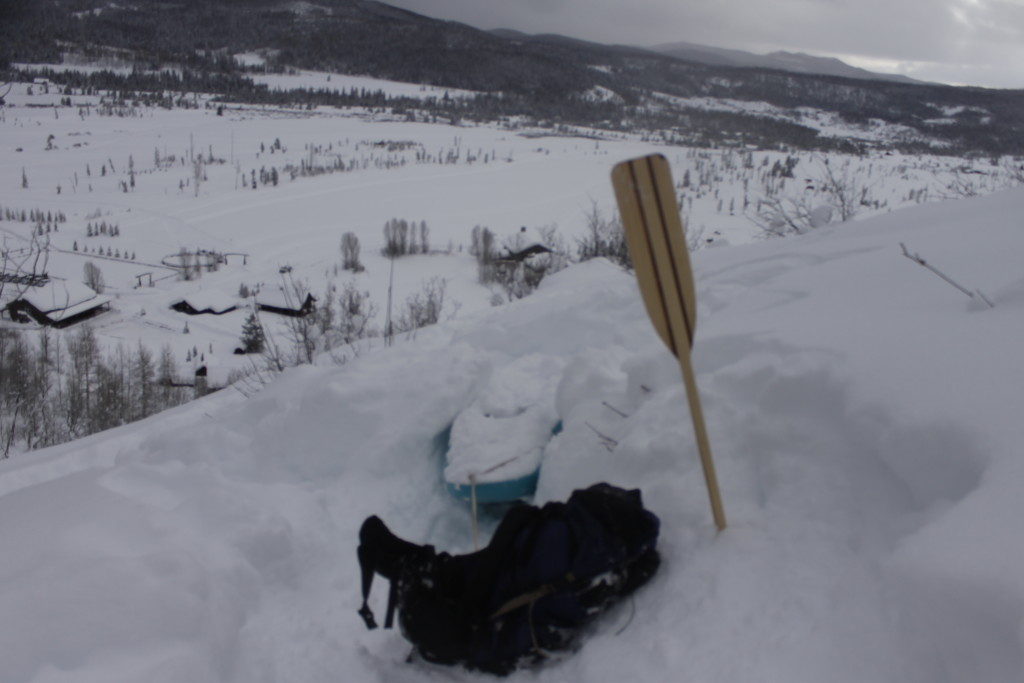
The climb was over. Finally.
I wiped sweat out of my eyes and surveyed the run. It was a south slope and the sun had just come out. Hence, a delicate crust was already forming on the powder.
I pulled my sprayskirt out from my jacket where I had stashed it in an attempt to keep it warm and stretchy.
There is something reassuring about this sprayskirt, a solid piece of neoprene that has stood up against the fury of waves and rivers. This pricey, “serious” piece of gear, helped me feel that, yes, I did know what I was doing up here, looking down a 35-degree snow slope through an aspen glen.
I used the paddle to dig out a notch in the slope where I could set the kayak down.
Getting the sprayskirt attached around the cockpit was a chore in the cold, even after I’d stashed it in my jacket to keep warm. The skirt wasn’t strictly necessary to go down the hill, but I did like how it kept the powder out of my lap. And I had that psychic comfort of knowing I was using a piece of gear that had served me well on past trips.
It did feel a little weird being in a kayak without a life vest however.
The backpack on my shoulders was another thing that was a little different from my standard kayak trip. I’d already given up trying to tie my snowshoes to the kayak for the way down. It was easier to put them into the nylon loops at the sides of my pack and fasten them together with a cam strap.
I put a ski helmet on and sunglasses. I wrapped a mesh t-shirt around my head like a burka to deflect all the powder that was about to come flying up at my face.
I looked at the canoe paddle, a cheap wood thing I’d bought in Minnesota. Having already busted up a couple kayak paddles last year, I decided that I wasn’t ready to invest in quality piece of equipment only to smash it in while jackassing in the snow.
Making it work
The mantra for this run was “Lean that mother!”
Just as I had leaned kayaks on edge to turn them in whitewater or waves, I planned to use the same principles to make the boat work on the snow. Adrenaline had helped me forget this principle on my earlier runs and I had tried turning by using the paddle alone. It wasn’t enough.
With that in mind, I planned to lean far enough to put my whole body against the snow if need be.
I pushed off and the kayak began grinding downhill at a slow crawl. I leaned the boat way to the left and dug the paddle in on that side. Sure enough, the boat began to turn that way. The sound of crust breaking beneath the bow accelerated at a slow grind to a faster swoosh. Snow began flying up into my face. Now, I was moving at a skier’s speed. I leaned right toward a gap in the scrub oak and the boat responded in a neat arc.
I was carving!
The boat responded to the powder exactly the way it was designed to turn on the river, the same way a skier would cut graceful curves into the alpine slope. I’d stumbled into a unified theory between snow and water.
I shot through the gap in the shrub and the powder started flying up in my face. The view throuh my sunglasses became dim, then obscure. Then I could see only see white. My hands clutched the paddle, unwilling to let go. The best I could do, while flying blind was to lean hard and hope to avoid hitting anything.
After a couple seconds the kayak stopped. I took the sunglasses off and saw that the lean had dug the kayak deep into the snow and basically thrown on the braking power that I’d needed — that along with the fact that I’d steered into some shrubs.
I put the sunglasses in a pocket and analyzed the route down the hill. I pushed off again and carved the rest of the way to where I’d started.
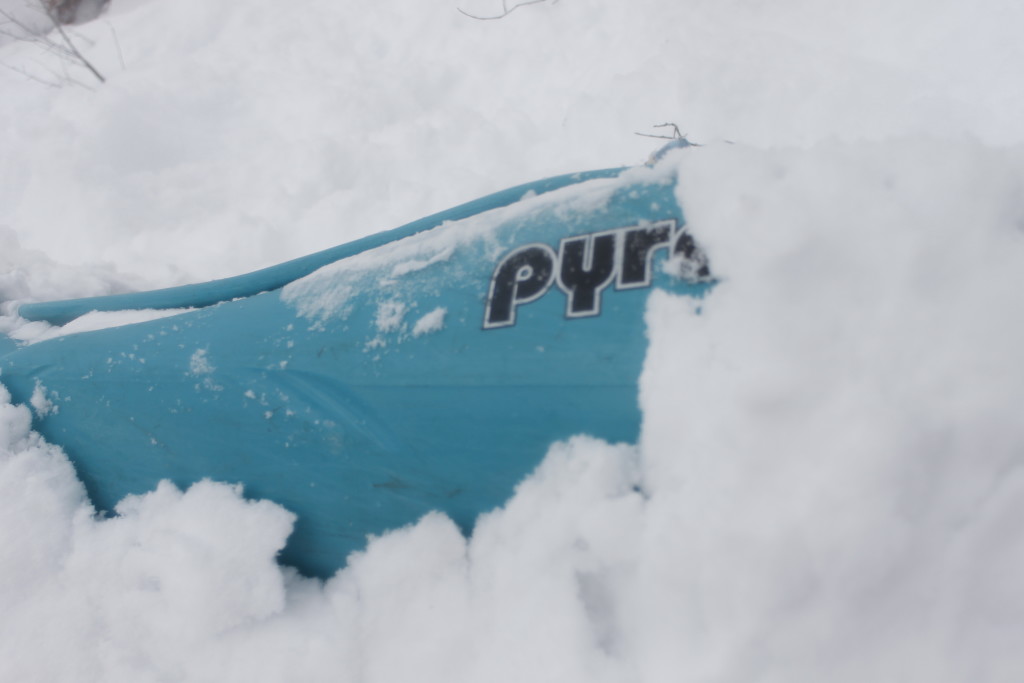
Can snow kayaking be the next hot sport?
Some witnesses have seen me going up and down the hill with my kayak and asked where I got the crazy idea.
No, I wasn’t the first person to think of it. There are some very entertaining online videos of others who have gone before me.
Nonetheless, this is hardly a popular sport yet. I’m enjoying something out which doesn’t necessarily have a large body of knowledge surrounding it and gives me the challenge of finding some things out on my own. Nor does snow kayaking (yet) have specialty products designed specifically for the job.
Note: If I were designing a kayak specifically for going down snow slopes, I would probably build metal edges into the sides for better carving. But that would subtract from the fun of doing something goofy in inadequate gear.
Snow kayaking is also a learning opportunity for boat technique
Many similarities between boating and snow sports became apparent after I started launching my down the hill.
Leaning for instance. I plan to steer with same aggressive edge that I used to carve the snow the next time I kayak in whitewater.
On the flip side, now that I have tried using a canoe paddle with snowshoes, I’m considering ditching poles on my next snowshoe trip with steep hills. Being able to brace against the powder without plunging deep into it (as with poles) is a huge advantage while climbing. So is being able to carve steps quickly.
The paddle also proved instrumental an igloo building project that I will describe in a future post.
Kayak vs. Skis
When the fresh snow falls on the hills and I have to decide whether I’d rather strap boards to my feet or go rambling in my yak, there are considerations to weigh:
Kayaks are slower to move uphill
When it comes to kayaking down a hill vs skiing, the former is obviously far more laborious to haul up to the top, at least if ski lifts aren’t a part of the equation. This is however, a killer workout that I’d would recommend to anyone who wants to get in shape for mountain climbing or trail running.
Kayak gear is tougher to work with in winter
Other changes that I had to make to kayak the snow vs. on water included moving the foot pedals way back so that I could fit inside the boat it wearing winter boots. A sprayskirt is nice for keeping the snow out, but getting it on and off in the cold is a bear.
Because snow kayaking only puts my head a couple feet above the slope, even more powder flies up in my face than what I’d encounter skiing. I’d probably do well to invest in some ski goggles before snow kayaking full time.
Kayaks are more forgiving when they hit stuff, but will hit more stuff
One advantage of the low body position is that I can’t get knocked off my feet like I can skiing, though a flip is definitely possible.
If I hit a tree in a kayak, it will go better than if I hit a tree on skis because I’ll have a bunch of plastic protecting me. The fact that the kayak doesn’t steer as well as skis means that collisions are harder to avoid.
Kayaks excel when terrain is deep and steep
The kayak’s extra volume means that it floats very well on snow. I got some decent runs on a powder day when some of my friends snowboarding friends could barely move. They ended up using the kayak tracks to pick up speed.
On groomed trails, snowboards or skis are definitely faster and more exciting than a kayak run. If I put glide wax on the bottom of my boat, it may change the equation.
Without deep powder, steering is possible, but sketchier. I took a run down a south slope that had crusted over and found myself going down the hill backwards with next to no control.
So far, deep powder and steep slopes have equaled the most fun for me, including one run where I went down slope in a chest-deep mass of churning snow.
While deep and steep snow has made for the best kayak runs for me, that stuff is also the hardest to drag a kayak through.
What I’d like to try next:
At some point I’d like to graduate to a double-bladed kayak paddle, though I doubt I’ll find anything cheap enough that I’d be willing to sacrifice anytime soon.
I’d also like to try setting a luge track in the hill and build banked turns with a shovel. It’d be fun to get up some speed without having to worry about steering so much.
I’m both excited and terrified to see what happens when I finally melt some glide wax onto the bottom of the kayak. I have a feeling that it will be a wild ride.
